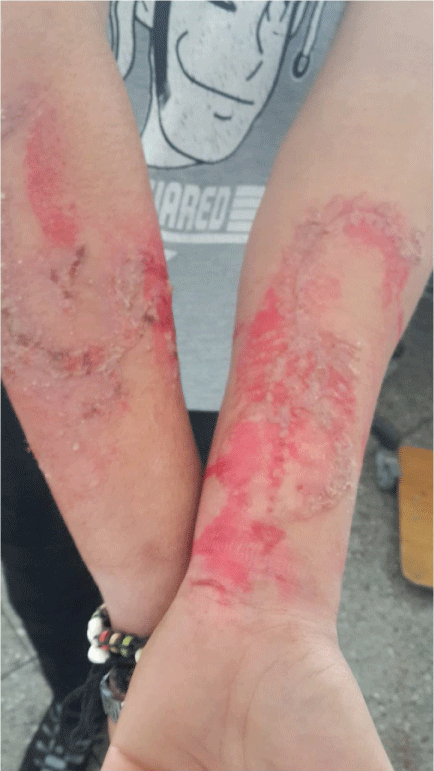Dreams of having beautiful black henna tattoos shattered by an allergic reaction.
A 16-year-old girl presented to the clinic with complaints of itchy lesions at the two tattoo sites, made with black henna on the front of the arms during a stay in a city of Marrakech.
The patient had no history of allergic reactions to natural henna, nor any of the family members had any history of an allergic reaction.
The two tattoos: scorpion and dragon tattoos, made with black henna, resulted in pruritic erythemato-squamous lesions at the tattoo sites.
On examination, the lesions were superinfected. The systemic review was unremarkable, and the patient had no other associated symptoms. (Figure 1).
The patient was diagnosed with contact dermatitis to black henna mixed with para-phenyldiamine (PPD).
Treatment was started with local and topical antibiotics, including amoxicillin and fusidic acid, for a duration of one week (Figure 2). Following this regimen, the patient was prescribed dermocorticoids and emollients for one month. The patient showed substantial improvement.
Tattoos are gaining popularity, especially among youth. Different inks are used for tattoos, including both permanent and transient inks. The popularity of black henna has surged among youth as it provides transient tattoos, but all that glitters is not gold!
Black henna may contain up to 16% para-phenyldiamine (PPD), which is way more than the allowed limit of 3%, usually seen in the hair dyes.
When a high quantity of PPD comes in contact with the skin, the acetylation pathways become saturated, leading to the accumulation of PPD derivatives in the skin. This then stimulates the dendritic cells and the lymphocytes of the sensitized individuals. The lymphocytes then produce cytokines, which result in the symptomatology.
The patients with contact dermatitis may present either immediately or within 48 hours with itchy, erythematous lesions. The skin becomes inflamed, irritated, burning, thickened, dry, and blistered.
Avoiding re-exposure is the key to managing such allergic reactions. Without exposure, the lesions disappear within a few days or weeks. Topical emollients/moisturizers alleviate the dryness. Topical steroids help with the inflammation and itching. Patients with superinfection may require topical antibiotics.
Severe cases may need systemic corticosteroids, phototherapy, immunosuppressive drugs, or immunomodulators.
Counseling remains indispensable in all cases. The patient should be adequately educated about the allergens, avoidance of exposure, and appropriate skin care. Additionally, the increasing use of PPD has given rise to a dire need for public awareness and regulation of its use.
References:
El Amraoui M, Bouhamidi A, Senouci K, Hassam B (2018) Black Henna Contact Eczema: Getting Handsome with Poison. Clin Med Img Lib 4:088. doi.org/10.23937/2474-3682/1510088




